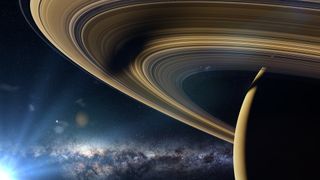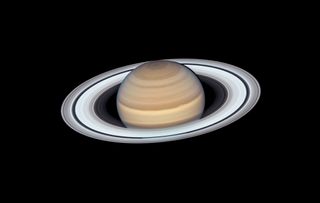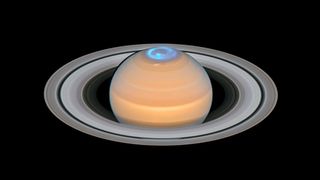Saturn: Everything you need to know about the sixth planet from the sun
Saturn is the second-largest planet in the solar system.

Saturn is the sixth planet from the sun and the second-largest planet in the solar system. It has a whopping 145 moons.
It's the farthest planet from Earth that's visible to the unaided eye, but the planet's most outstanding features — its rings — are better viewed through a telescope.
Although the other gas giants in the solar system — Jupiter, Uranus and Neptune — also have rings, Saturn's rings are particularly prominent, earning it the nickname the "Ringed Planet."
Related: The 10 most Earth-like exoplanets
When was Saturn discovered?
Saturn has been known since ancient times and was observed by cultures all over the world. The planet is visible with the naked eye and to ancient cultures, appeared as a bright light shifting among the stars. There are numerous names and mythologies associated with the planet.
The International Astronomical Union, which is the body that represents astronomers around the world, chose the name Saturn to represent the planet. Saturn, according to Encyclopedia Britannica, is associated with the Roman god of agriculture.
In Greek mythology, from which the Romans borrowed, Saturn was called Cronus. Saturn/Cronus is most famous for being one of the Titans, a group of gods who fought with the next generation of gods led by Jupiter (in Roman mythology) or Zeus (in Greek mythology). Your culture may have different stories and monikers associated with Saturn, however.
What are 5 facts about Saturn?
1. Saturn is the farthest planet from Earth discovered by the unaided eye and has been known since ancient times.
2. Saturn is 9 times wider than Earth.
3. Saturn has the second-shortest day in the solar system.
4. Saturn has a strange hexagon-shaped jet stream around the north pole.
5. Saturn is the only planet in the solar system with an average density that is less than water. If you could find a bathtub big enough to fit the gas giant, Saturn would float!
What is Saturn made of?
Saturn is a gas giant made up mostly of hydrogen and helium. Saturn's volume is greater than 760 Earths, and it is the second most massive planet in the solar system, about 95 times Earth's mass. The Ringed Planet is the least dense of all the planets and is the only one less dense than water.
The yellow and gold bands seen in Saturn's atmosphere result from superfast winds in the upper atmosphere, which can reach up to 1,100 mph (1,800 km/h) around its equator, combined with heat rising from the planet's interior.
Saturn rotates about once every 10.5 hours. The planet's high-speed spin causes Saturn to bulge at its equator and flatten at its poles. The planet is around 75,000 miles (120,000 kilometers) across at its equator, and 68,000 miles (109,000 km) from pole to pole.
Is Saturn the only planet with rings?
Galileo Galilei was the first to observe Saturn's rings in 1610, although from his telescope the rings looked more like handles or arms. Forty-five years later, in 1655, Dutch astronomer Christiaan Huygens, who had a more powerful telescope, proposed that Saturn had a thin, flat ring. Today we know that many planets and even some smaller bodies have rings. Examples include Jupiter, Uranus and Neptune.

As scientists developed better instruments, they continued to learn more about the structure and composition of the rings. Saturn has many rings made of billions of particles of ice and rock, ranging in size from a grain of sugar to the size of a house. The particles are believed to be debris left over from comets, asteroids or shattered moons. A 2016 study also suggested the rings may be the carcasses of dwarf planets.
The largest ring spans 7,000 times the diameter of the planet. The main rings are typically only about 30 feet (9 meters) thick, but the Cassini-Huygens spacecraft revealed vertical formations in some of the rings, with particles piling up in bumps and ridges more than 2 miles (3 km) high.
The rings are named alphabetically in the order they were discovered. The main rings, working out from the planet, are known as C, B and A. The innermost is the extremely faint D ring, while the outermost to date, revealed in 2009, is so big that it could fit a billion Earths within it. The Cassini Division, a gap some 2,920 miles (4,700 km) wide, separates rings B and A.
Mysterious spokes have been seen in Saturn's rings, which appear to form and disperse within only a few hours. Scientists have conjectured that these spokes might be composed of electrically charged sheets of dust-size particles created by small meteors impacting the rings, or by electron beams from the planet's lightning.
Saturn's F Ring also has a curious braided appearance. The ring is composed of several narrower rings, and bends, kinks and bright clumps in them can give the illusion that these strands are braided. Impacts from asteroids and comets have also altered the appearance of the rings.
Late in its mission, the Cassini spacecraft traveled closer to the rings than any other spacecraft. The probe collected data that is still being analyzed, but it has already provided insights about the colors of some of Saturn's moons. In the gaps between the rings, the probe found unusually complex chemicals in the "ring rain" of debris falling from the rings into the atmosphere and made new measurements of the planet's magnetic field, which produces a powerful electron current.
Saturn FAQs answered by an expert

Leah Sacks is a Ph.D. student working with Catherine Neish at Western University in Ontario, Canada on planetary tectonics of icy moons. Her research focuses on understanding chasmata formation and tensile stresses on the ice crusts of several small moons.
Is Saturn losing its rings?
Saturn is ever losing its rings, but very very slowly. They are not disappearing at a rate we would be able to see clearly with a telescope from Earth, but as the rocks and ice of the rings move around Saturn, they are [slowly] losing pieces into Saturn as gravity pulls them in.
What is Saturn made of?
Saturn has several layers, but almost all of them are made of hydrogen in different states. Liquid and solid metallic hydrogen are thought to be the biggest components of Saturn's core, while hydrogen, helium, water, and some small amounts of other gasses, including ammonia, make up the atmosphere and clouds. The rings themselves are made almost entirely of water ice.
Can humans live on Saturn?
As a gas giant planet, humans would have no solid surface to stand upon and can therefore not live on Saturn. It is possible that they could live upon one of Saturn's moons that has a solid surface, but the complication is those moons do not have a breathable atmosphere. There's a far better chance that humans will explore the Earth's moon and Mars in the near future until better technology can be developed to assist with the exploration of the Saturn system.
Saturn's moons
Saturn has 145 moons. The largest, Titan, is slightly larger than Mercury and is the second-largest moon in the solar system behind Jupiter's moon Ganymede (Earth's moon is the fifth largest).
Some of the moons have extreme features. Pan and Atlas are shaped like flying saucers; Iapetus has one side as bright as snow and one side as dark as coal. Enceladus shows evidence of "ice volcanism": a hidden ocean spews out water and other chemicals from the 101 geysers spotted at the moon's southern pole. A number of these satellites, such as Prometheus and Pandora, are referred to as shepherd moons because they interact with ring material and keep the rings in their orbits.
Though scientists have identified many moons, Saturn has other small moons constantly being created and destroyed.
Saturn's aurora
Stunning aurora light shows have been spotted on Saturn. Similar to auroras found on Earth, these ribbons of light are produced when the solar wind sweeps over the planet and reacts with the gas giant's atmosphere.
Though unlike on Earth, Saturn's auroras are mainly visible in ultraviolet light. As such, they can only be observed with space-based telescopes because Earth's atmosphere blocks this portion of the electromagnetic spectrum.
Saturn's aurora was first spotted by NASA's Pioneer 11 spacecraft when it observed a far-ultraviolet brightening over Saturn's poles in 1979, according to NASA. Voyager 1 and 2 also provided a basic description of the aurora when they flew past in the early 1980s. However, it wasn't until 1994-1995 that we caught the first glimpse of the impressive light show courtesy of the Hubble Space Telescope's Wide Field and Planetary Camera.

Saturn missions and research
Pioneer 11 was the first spacecraft to reach Saturn in 1979, flying within 13,700 miles (22,000 km) of the Ringed Planet. Images from the spacecraft allowed astronomers to discover two of the planet's outer rings, as well as the presence of a strong magnetic field. The Voyager spacecraft helped astronomers discover that the planet's rings are made up of thinner ringlets. The craft also sent back data that led to the discovery of three of Saturn’s moons.
The Cassini spacecraft, a Saturn orbiter, was the largest interplanetary spacecraft ever built. The two-story-tall probe weighed 6 tons (5.4 metric tons). It helped identify plumes on the icy moon Enceladus and carried the Huygens probe, which plunged through Titan's atmosphere to successfully land on its surface.
After a decade of observation, Cassini returned incredible data about the Ringed Planet and its moons, as well as a photo re-creating the original "Pale Blue Dot" image, which captures Earth from behind Saturn, in 2013. The mission concluded in September 2017 when Cassini, low on fuel, deliberately crashed into Saturn to avoid the slight chance of the craft crashing into and contaminating a habitable moon.
While there are no future missions planned for Saturn, scientists have proposed missions to probe the icy moon Enceladus or Titan. In 2019, NASA announced their plans to launch their rotorcraft-lander Dragonfly in 2026 and which will arrive on Titan in 2034. Dragonfly will search for the chemical building block for life on Titan using its many onboard instruments, including a mass spectrometer.
Saturn's influence on the solar system
As the most massive planet in the solar system after Jupiter, the pull of Saturn's gravity has helped shape the fate of our solar system. It may have helped violently hurl Neptune and Uranus outward. Along with Jupiter, it might also have slung a barrage of debris toward the inner planets early in the system's history.
Scientists are still learning about how gas giants form, and run models on early solar system formation to understand the role that Jupiter, Saturn and other planets play in our solar system. A 2017 study suggests that Saturn, more so than Jupiter, steers dangerous asteroids away from Earth.
Additional resources
To learn more about Saturn check out NASA's webpage. You can read more on the Voyager missions' trips to Saturn at the Jet Propulsion Laboratory. For an in-depth look into the Saturn system and the planet's history, check out "The Saturn System Through The Eyes Of Cassini" by NASA.
Bibliography
Marley, Mark, William B. Hubbard and Bonnie Buratti, "Saturn planet", Enyclopedia Britannica, last updated Nov. 2, 2022, https://www.britannica.com/place/Saturn-planet/.
James Pollack, "The rings of Saturn", Space Science Reviews, Volume 18, October 1975, https://doi.org/10.1007/BF00350197
Linda Splinker, "Cassini-Huygens’ exploration of the Saturn system: 13 years of discovery", Science, Volume 364, Hune 2019, https://doi.org/10.1126/science.aat3760
European Space Agency (ESA), "Facts about Saturn", January 2022.
Thierry Fouchet et al, "Saturn: Composition and Chemistry", Saturn from Cassini-Huygens, Springer, 2009, https://doi.org/10.1007/978-1-4020-9217-6_5
Erik Asphaug and Andreas Reufer, "Late origin of the Saturn system", Icarus, Volume 223, March 2013, https://doi.org/10.1016/j.icarus.2012.12.009
Join our Space Forums to keep talking space on the latest missions, night sky and more! And if you have a news tip, correction or comment, let us know at: community@space.com.
Get the Space.com Newsletter
Breaking space news, the latest updates on rocket launches, skywatching events and more!

Charles Q. Choi is a contributing writer for Space.com and Live Science. He covers all things human origins and astronomy as well as physics, animals and general science topics. Charles has a Master of Arts degree from the University of Missouri-Columbia, School of Journalism and a Bachelor of Arts degree from the University of South Florida. Charles has visited every continent on Earth, drinking rancid yak butter tea in Lhasa, snorkeling with sea lions in the Galapagos and even climbing an iceberg in Antarctica. Visit him at http://www.sciwriter.us
- Scott DutfieldContributor
- Daisy DobrijevicReference Editor
